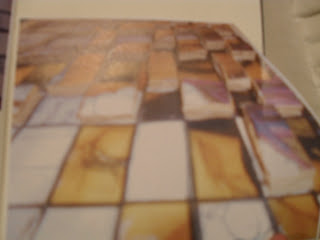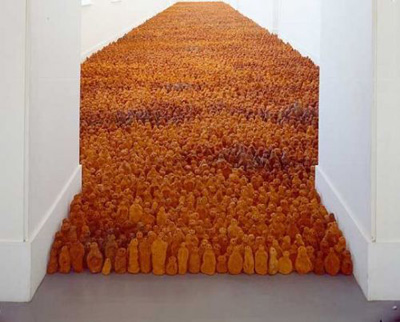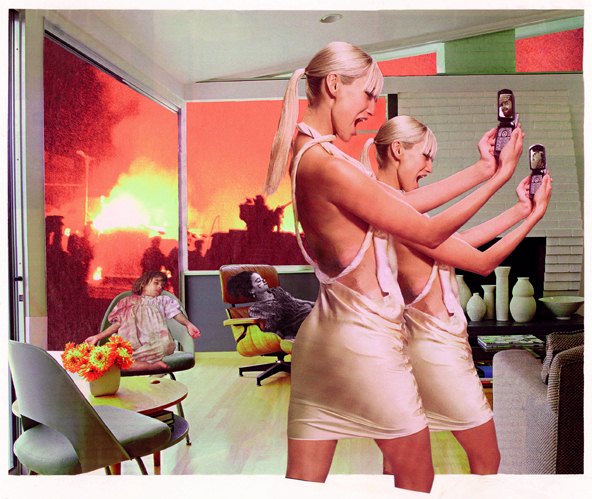I combined my images of the secret postcards in a weave which I then worked into. Raising sections on cardboard.
Whitewashed background
Enlarged section onto a canvas.
Contextual E-file, recording progress of work within Lincoln's Graphic Design Degree
Monday, 19 December 2011
Movement Workshop
Marchel Duchamp 'Nude descending a staircase No. 2'
combines both futurist and cubist movements.
Eadweard Muybridge 'The Horse in Motion'
Slow motion stills, proved that a horse runs with always one foot on the floor.
Alexander Calder produces hanging mobiles on a wire.
Julie Brixley-WIlliams, dancers making marks with their feet
Maryclare Foa, Walking Drawings/ Drawings from a train.
Markings are erratic and overlap.
My attempts of a walking drawing, very overlapped and sporadic.
Still life in which people would individually pose with the apparatus. Overlapped graphite. Difficult to negotiate perspective.
Alexander Calder produces hanging mobiles on a wire.
Julie Brixley-WIlliams, dancers making marks with their feet
Maryclare Foa, Walking Drawings/ Drawings from a train.
Markings are erratic and overlap.
My attempts of a walking drawing, very overlapped and sporadic.
Still life in which people would individually pose with the apparatus. Overlapped graphite. Difficult to negotiate perspective.
Postsecret.com
www.postsecret.com is where anonymous people send postcards with their secrets on. These are really revealing about the stranger and can show their identity.
This method of sharing secrets, is also present in music videos, such as Every Avenue: Tell me I'm a Wreck.
All-American Rejects: Dirty little secret.
I created a postbox and left empty postcards on top to let people write their secrets anonymously, just like the website postsecret and music videos. I left it in a public area so there is minimal pressure. I then chose subjects and photographed them holding the revealing secrets infront of their face.
'I'm a wizard'
This method of sharing secrets, is also present in music videos, such as Every Avenue: Tell me I'm a Wreck.
All-American Rejects: Dirty little secret.
'Babies and small children scare me'
'I'm a wizard'
Gillian Wearing
Wearing's juxtaposition of the well dressed businessman and the very vulnerable statement carries a heavy impact. I'm desperate 1992/3
Very honest and brave statement. 'I have been certified as midly insane' 1992/3
I used Walsh's white-out method:
Very honest and brave statement. 'I have been certified as midly insane' 1992/3
I used Walsh's white-out method:
Walsh inspired Photography
I used emulsion to white out the background and paint in the hair and top using acrylic, giving the image a cartoon feel. The end product is very striking and the scribbled out face is a obviously a very quick mad mark, perhaps out of anger or jealousy. That is for the viewer to interpret.
Again I chose another solitary figure to concentrate on, I repeated the white-out technique to focus on the scribbled out head of the figure and I thought that it worked out well here, the red leggings give a real anger and passion that may reflect the artists emotions.
Finally I chose a male figure sitting on the stairs, this lonely pose shows a possible rejection or bitterness. The viewer can conjure their own scenario and I like how this person's identity is a mystery.
Moving on from Walsh's childish scribble, I markered out the main figures eyes. By white washing the other figures, all attention is focused on the central female. Her thumbs up and tight smile is very posed and by singling her out, it shows the artist's anger and disgust at her falseness.
I took the same scenario and swapped the figure's heads, almost mocking their relationship and the viewer may wonder what the subject's relationship may be and why the artist is making fun of them.
Walsh's Photographs
Carolyn Walsh, Silkies, 2007.
I like the method of whitewashing out the background and the way Walsh has obscured the face, concealing the woman's identity in such a violent scribble.
I like the method of whitewashing out the background and the way Walsh has obscured the face, concealing the woman's identity in such a violent scribble.
Wall covering inspired by Kendall and Gormley
After researching Kendall and Gormley's works, I asked some peers and tutors to draw a simple flower. I chose that subject matter because it was easy. I then arranged the pictures in an overlapping and interesting way and sewed vertical lines to attach the pieces. I also raised the edges as Kendall did in her 'Hidden White Room'
Kendall's Wallcoverings
Tracy Kendall produces hand painted wallpaper with subtle elegance, gives walls innovative textures and forms - spectacular visual impact. White card:
Hidden White Room:
Both designs from the stripe collection. I like the effect of the layering and the idea of combining it with a concept like Gormley's, but obviously not on the same scale.
Gormley's Field for the British Isles
Focusing on the idea of identity, I looked at Gormley's large scale works, whereby he got the public to mould a piece of clay, the size of their hand, into a basic figure. Approx. 35000 figurines made, varied from 8 -26cm high. Reflect the variation of society and the individuals within. Very imposing exhibition.
Collage Workshop
Early Cubists
George Braque and Pablo Picasso started to experiment with collage with 1912, using it as a background surface.
Above: Braque's Fruitdish and Glass, papier colle and charcoal on paper, 1912
George Braque and Pablo Picasso started to experiment with collage with 1912, using it as a background surface.
Above: Braque's Fruitdish and Glass, papier colle and charcoal on paper, 1912
Above: Picasso's Bottle of Vieux Marc, Glass, Guitar and Newspaper, 1913
Juan Gris was influenced by their work and took the process further by rubbing a wooden table to show the grain.
Above: Gris' Breakfast, 1914
During the 20s and 30s only used collage to explore textural qualities.
Kurt Schwitters' Merz 1921
Schwitters' Merz Building took shape between 1920 - 1936 - altered whole room with collage and lived in the space for several months.
During the Pop Art era of the 60s, Robert Rauschenberg used everyday imagery from newspapers and magasines, transferring them onto collage. Juxtaposed images for the viewers' own interpretation.
Rauschenberg's Retroactive I, 1964
Rauschenberg's untitled, 1954
Collage evolved with the digital age into photomontage, as artist increasingly used photoshop etc.
Hannah Hoch's Cut with the Kitchen Knife through the Beer-Belly of the Weimar Republic, 1919,
Martha Rosler's Photo-op, 2004
David Mach
John Stezaker
Chris Ofili's No woman, no cry - in response to the murder of Stephen Laurence, portraying the tears of the victim's mother
Subscribe to:
Comments (Atom)



















































